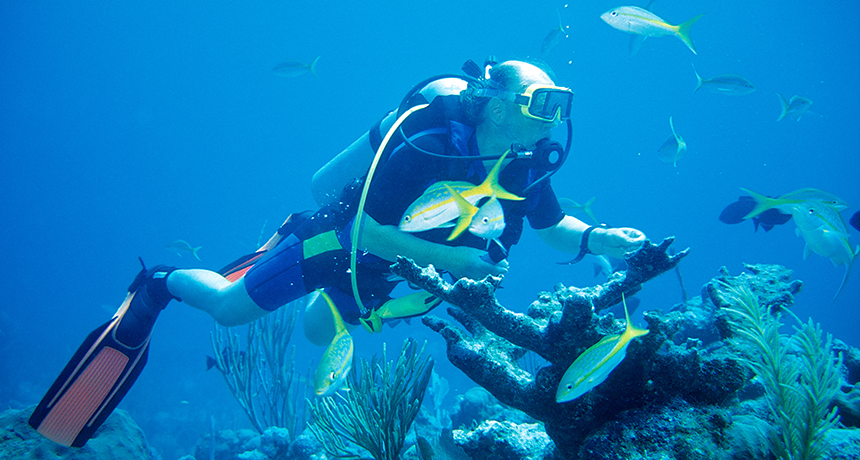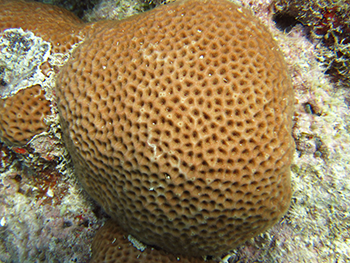Cuba: How politics has become a hurdle for its researchers
Cuban scientists struggle to receive U.S. equipment and publish in major journals

Tourists can visit Cuba’s beautiful underwater reefs, but a trade embargo with the United States makes it difficult for Cuban scientists to study these reefs.
Wafue/iStockphoto
By Bryn Nelson
Imagine you’re a scientist in the Caribbean who studies corals. Your work could help others learn how to protect endangered reefs and the ecosystem of fishes and other creatures that those reefs support. But major dealers of underwater cameras cannot sell them to you. So you can’t photograph the reefs in the detail you need to show how they’ve been changing over time. Stores in other countries can’t sell you drills, either, to bore through the rocky reefs and collect samples. You log onto to your computer and find that your access has been blocked to some U.S. websites and apps, such as Google Earth. These sites would have displayed important details about the coastline and reef system that you study.
Even if, despite those obstacles, you somehow manage to get your work done, you still can’t get many U.S. research journals to publish your findings.
This isn’t a fictional tale. These are the types of challenges that scientists in Cuba face every day.
Despite a complicated history, the United States and Cuba used to get along. But soon after a Cuban revolution in 1959, the country adopted communism, a different form of government. That change brought an abrupt end to America’s relationship with this island nation, just 145 kilometers (90 miles) south of Key West, Fla.
To punish Cuba for turning to communism, the U.S. government imposed what’s known as a trade embargo. In Cuba, it’s widely called, “el bloqueo,” or the blockade. The policy banned U.S. citizens from buying anything from Cuba. Nor could they sell anything — including research tools and other equipment — to anyone in Cuba.
The embargo is a non-traditional type of obstacle to diversity in STEM (science, technology, engineering and math). Often scientists can’t find work in STEM fields or aren’t taken seriously because of biases against their skin color, gender or health and fitness. In this case, a bias against the politics of a scientist’s government may stand in the way of someone being able to do high quality research — and get it published.
Publication bans can effectively silence scientists
Jorge Angulo Valdés teaches in the Cuban capital at the University of Havana. He also leads the Marine Conservation Group there, at Cuba’s Center for Marine Research. He attended the 2017 annual meeting, in Boston, Mass., of the American Association for the Advancement of Science (AAAS). There, Angulo Valdés and other Cuban scientists talked about the challenges they face in performing good quality science.
Corals in many parts of the world are sick or dying. Not so in Cuba. This island nation has some of the healthiest reefs in the Caribbean Sea. Understanding why they are so healthy might guide reef managers elsewhere.
Many fish and other animals, such as sharks and manatees, travel easily from Cuban waters to those in the United States and Mexico. So can coral larvae. These immature forms of the tiny animals drift with water currents until they settle to form reefs. Keeping Cuba’s reefs healthy, then, could help replenish corals and other animal populations throughout the Caribbean, Angulo Valdés says.

Patricia González Díaz directs the Center for Marine Research at the University of Havana. She also is an expert on coral reefs. Her research could be useful to biologists in the United States and elsewhere. But for them to learn about her findings, she has to publish them.
U.S. journals are a leading conduit for the release of such research throughout the world. But a U.S. journal rejected her research — and not because its editors thought it wasn’t worth publishing. The journal told her U.S. colleagues that it was afraid to publish studies from her or other Cuban scientists. At the AAAS meeting, the researchers explained that the journal didn’t want to break the rules of the U.S. trade embargo.
Many U.S. scientists have tried to cooperate with Cuba’s researchers on marine science. Consider Daria Siciliano. She is a marine biologist at the Marine Science Institute of the University of California, Santa Cruz. She has worked with González Díaz to study Cuba’s corals. She notes that there are alternative ways to publish. Cuba has some journals of its own. But the research in them is not as visible as that in U.S. journals.
“The problem with Cuban [research papers] is that they’re just buried in some journal that doesn’t usually make it outside the country,” explains Siciliano. And if the knowledge of Cuban scientists isn’t widely known, it can’t inform other scientists, which is how science should work.
Tamara Figueredo Martín also works at the University of Havana’s Center for Marine Research. After hearing from other Cuban researchers that they couldn’t get their studies accepted by U.S. journals, Figueredo Martín decided to not even try. She was afraid her studies would be rejected too.
No sale!
González Díaz struggles not only to get her research published but also to get needed equipment.
She studies the health of Cuba’s corals. By boring down into ones called massive starlet corals, which look like pockmarked boulders, she could extract samples. Each should reveal the history of that coral community and its reefy surroundings. Scientists often compare this process to what they can learn from tree rings.
Sampling that coral requires an underwater drill. But the equipment is expensive and Cuban researchers often can’t afford it.
But even if she had the money for it, González Díaz reported at the AAAS meeting, companies would not sell it to her. The reason: a U.S. company makes it.
U.S. colleagues have helped her by visiting Cuba and lugging along their own drill. When they did this, however, they first had to buy a license from the U.S. government to take that equipment into Cuba. And getting permission took months. Plus, the law then required that the U.S. scientists bring everything back home when they left Cuba.
“Imagine that you are conducting a project, for instance, for tagging animals,” Figueredo Martín says. You could bring tags to Cuba and attach them to sharks or sea turtles to follow their journeys. But you couldn’t control where each animal and its tag would go. “How could you bring it back to the states after your work?” she asks.
Why not buy tools from countries other than the United States? The complicated rules of the trade embargo have eased somewhat. But according to the U.S. government, even companies in foreign countries cannot sell equipment to Cuba if they contain U.S.-made parts worth more than one-fourth of a tool’s total value.
Researchers are seeing some signs of progress. In 2014, the United States and Cuba restored official ties. They agreed to work jointly on environmental and research goals. Last year, the U.S. government also made it easier for Americans to conduct research with Cuban colleagues.
U.S. researchers working with González Díaz also convinced the Bulletin of Marine Science to begin publishing research papers by Cuban scientists. The journal now plans to devote an entire issue to research in Cuba. And it asked González Díaz to help with it.
Expected to appear in late 2018, that special issue could be a “big step,” Figueredo Martín says. When other journals see it, she observes, maybe they, too, will be less afraid to publish Cuban science.
The trade embargo has remained in place, however, and the U.S. government partially reversed its more lenient course in June. That’s when it announced a new, tougher policy. It will now ban most U.S. businesses from working directly with companies owned or operated by the Cuban military. The problem: In Cuba, the military and other parts of the government still control most businesses.
Despite these challenges, Figueredo Martín is hopeful that the two countries’ relationship — and their ability to do research together — will continue to improve. “I think that things need to change, so I’m very optimistic,” she says.
If they do, it will help break down yet another barrier to diversity in science. It will give voice to researchers who, owing solely to where they were born, are made to feel like second-class citizens of the science community.
Note: This story has been changed to account for the fact of U.S. websites that are blocked in Cuba, not all are due to that government’s censorship. Some have been due to self-censorship by U.S. website owners.







